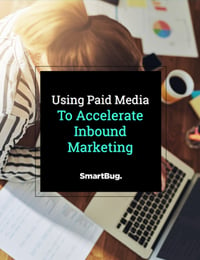
How to Choose the Right Ad Targeting Strategies for Your Business
September 2, 2021
Are you asking yourself, “Is this another ‘how to’ article I can skim past and just read the headers?” I surely hope not, because then you will miss all the comedy packed into the copy.
Choice is yours though. I structured it to be digested in five minutes or less.
I request that before you skim, you pause, take a deep breath, slow down the rushing world around you, and ask yourself: What constitutes the idea of “right” in justifying my paid media or social ad spend?
Here are my fast facts or steps, if you will.
Step 1: Determine what you want to market.
Start with your amazing unicorn content.
Unicorn content? What is this buzzing term you speak of?
Simply put, unicorn content could be a blog post that absolutely blows up on your social channels, climbs to the top of the Google rankings, and drives a ton of traffic to your landing pages. Keep your eyes and data-driven mind peeled for this overachieving unicorn content. It really is the first step to your ad targeting strategy.
Once you spot the unicorn on your content quest, repurpose it as an ad on the platform of your choice (they each have their strengths, so keep your product, message, service, and offering in mind when making this decision).
With at least one ad in place, make the original blog into an infographic, an e-book, and then a video. Literally exploit this content for all its creative worth and customize the offer for every step of your buyer’s journey. Now you are prepared to showcase your unicorn and gather inbound data at the zoo, circus, and museum for as many interested audiences as possible. In less metaphorical words, you can now test this content in various formats to your key audiences to optimize it to work even harder.
Prioritize the SEO value your original content and new content has, but also make sure it is engaging. I know this isn’t always easy (thus the unicorn metaphor), but keep your chinny-chins high—it is possible.
Note: If you don’t have any unicorn content, we need to have a chat. There is no sense wasting your money on ad spend if there is not a clear call to action you want to promote. Capturing your audience is a gift, so find that unicorn (or at least your “Contact Us” page plus some creativity)!
Please treat your unicorns responsibly and remember, no unicorns were harmed or put in danger for the making of this blog post.
Step 2: Determine your target audience.
Use audience insights.
Don’t go in blind when it comes to advertising your unicorn content. Use the insights tools each ad platform provides. Here are a few good ones to start with and build upon.
For Facebook, you can target competitor fans. This strategy learns who you’re competing with on Facebook, then targets your competitors’ existing fans. Cool right? Seems like a quick win, and it is. Check out the full step-by-step quick guide to setting this up.
For LinkedIn, one of the most effective and outright simple audience targeting strategies is translating job titles into targeted keyword research and audiences.
Don’t skip remarketing.
Remarketing lists for search ads (RLSAs) are a big deal and an excellent ad targeting strategy. Ten out of 10—I highly recommend it, in fact we all highly recommend it (we being marketers across the globe). Short attention spans and life business can cause a user to abandon their cart and disappear mid-conversion, despite the fact that they want to purchase or reshare your product offering!
Facebook has custom audience targeting options you won’t want to skip. Choose to market your ads to folks who have recently viewed your website, looked at sales pages, or have looked at specific products (this will be your remarketing audience—didn’t want you to miss them). On the flip side, you can also choose to exclude customers, if you think they are unlikely to convert again.
Google offers this audience targeting strategy as well. Create a Google remarketing list, and you will be off to the unicorn content races!
Lookalike Audiences are another way to remarket. They allow you to build targeted lists of potential customers who share characteristics with people who already buy from you. As a quick and broad example, if your buyer persona data or ideal customer profile is a mid-40-year-old equestrian enthusiast who lives in Southern Pines, North Carolina, you can get ahead of the game by targeting other mid-40-year-olds who live in Southern Pines. Facebook harbors a lot of this insight, but in a more sophisticated and data point-driven algorithm, so leverage their efforts and maximize your returns.
If you can, use motivated audiences ...
By motivated, I mean engaged, further down the funnel audience members. This is what inbound marketing would call “buyer audiences” in consideration or decision stages.
With Google Ads, you can expand reach into in-market audiences using display ads and more. These audiences have researched your product or service, but they may not have researched you exactly. This audience is backed by data and intent and already on a journey you can help with ... so help! Learn more about Google’s audience targeting.
On Facebook, you can use “recent purchasing behavior” as an audience ad targeting strategy to build a data-backed audience. Learn where they have been, what they are buying and if your business falls in line or...missed the opportunity!
... But keep this in mind.
Your audience constantly has to be refined because you’re essentially evolving your original hypothesis. In digital marketing, never think of your audience, your assets or your efforts or anything really, as permanent. Staying agile and open to your platforms' agility is a key element to successfully bolster your ad targeting strategies.
Step 3: Determine relevance.
Get granular and layer your targeting efforts.
There are strategic ways you can hone in on your audience’s journey. Let’s say your amazing piece of unicorn content has a unique 15-second ad with an underlying Friends theme. You can additionally target an audience that has expressed an interest in the Friends television series. The audience will be slimmer, but in theory, your engagement rate will be higher.
Another approach is to work backward from the two audiences and create a specific ad set for these folks. This feature is called “narrow further” with Facebook, which allows you to add demographic details or interest details to your targeting efforts.
Want to get real into the nitty-gritty? How much time do you have to wager your pretty penny? This one is pretty cool to consider, if you choose the right platforms to harness these details: consult psychographics. Psychographics keep your buyer’s journey top of mind when getting into the nitty-gritty of your ad sets. This approach considers your customer “bios” to centralize your ad spend in focal areas of “values, affinities, and motivations” in relation to “lifestyles, priorities, and attitudes,” according to WordStream.
Consult relevance scores.
Please look at these! They are excellent insights into why your ad could be performing poorly. Every platform has a different approach to determining these metrics, but more often than not, it is some combination of:
Why jump through these hoops? Really, these platforms are doing you a favor. They don’t want to waste the user’s time showing them an irrelevant ad (and duh, this is saving you money by cutting out the unqualified folks). Follow the steps, and always have your ideal customer and their unique journey in mind.
Step 4: This is a big one—determine your authenticity.
I will keep this concise and bulletize the list for time’s sake. Do not:
- Upload purchased lists of email addresses on any platform
- Assume all targeted ads are private on any platform
- Search for your own ads; instead, trust the previews each platform offers
- Spam or overshare to those who aren’t interested—no more ads than are necessary, please
- Miss out on mobile traffic; instead, optimize your ad for mobile
- Ignore your website—it should match your ad content and be relevant
- Be impatient, because building leads and traffic takes time
Do your ad targeting strategies hold up in comparison?
Be honest—did you skip a step or two? Are you on my naughtly list as an offender of the one or more of the absolutely do-not list bullets? It’s okay, I will 100 percent still be your friend. In fact, we can toast to your luck if your ad platforms have not disapproved, disqualified, or banned you forever ... yet. So don’t keep pushing your luck, friend.
Quit while you're ahead and start making strategic moves.
We all make mistakes, but the difference is how we decide to learn from them, right? At SmartBug®, our super team specializes in creating unicorn content, learning your business, determining your audiences, and maximizing your conversion rates from inbound to paid efforts. Check out how you can start using paid media to accelerate inbound marketing.

About the author
Delanie Nelson was formerly an Inbound Marketing Strategist at SmartBug Media near Orlando, FL. From branded storytelling, graphic design, videography, photography, content writing, sales and trade-show operations, Delanie has no fear of the unknown should there be a worthy ROI. In her extra time you might be able to find her playing hide-n-seek with her family, emphasis on might...she is an expert hider. Read more articles by Delanie Nelson.





















